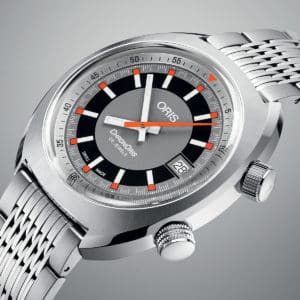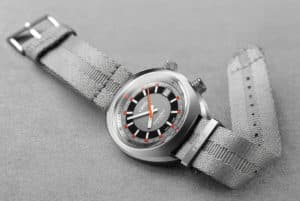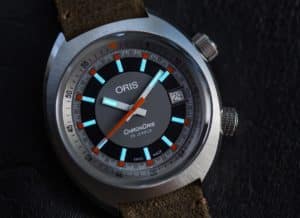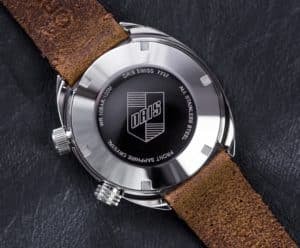The latest version of Oris’s racing watch, the Chronoris Date, has no timing function. Is this good or bad?
Oris’s racing chronograph – the Chronoris from 1970 – has been back on the scene since last year, this time making its appearance as a three-hand model: the Chronoris Date. The oval stainless-steel case, a rotating inner bezel for timing minute intervals, the date display and the three centrally mounted hands are unchanged. However, the orange seconds hand is no longer used for the timing function, but is limited to the standard passing of seconds. Oris has deviated from the model’s design as a chronograph nearly half a century after its first issue. But strangely enough, this doesn’t detract from its appeal. It has the same number of hands as the 1970 Chronoris (see the timeline on the next spread) and has an even neater and sportier look than the original.

How can the number of hands be the same as on the 1970 chronograph? It’s due to the unusual design of the historic model. The Caliber 725, which Oris had built according to its own specifications by chronograph specialist Dubois Depraz, did not have a continuous seconds or a minutes or hour counter. And there was only a single stopwatch hand in addition to the two hands that showed the time. It was possible to time an interval of several minutes by adjusting the rotating inner bezel with the additional crown at 4 o’clock. This solution, which was certainly more cumbersome to use than a conventional chronograph, enabled Oris to create a clear, minimalistic and unique look with its very first chronograph.
The current Chronoris looks even tidier than the original model, mainly because it has no tachymeter track, which is unnecessary without a timing function. And the silver-tone rotating inner bezel, which replaces the original orange three-quarter inner ring, increases the symmetry of the dial. Oris has kept the orange color for the stopwatch hand and also to highlight the hour markers.
The watch’s unique steel bracelet, with no less than 15 rows of links and a safety folding clasp, fits well with the sporty retro design. It looks good and feels great thanks to curved links and solid construction with screwed pins. The singlesided folding clasp with deployant buttons lies snugly against the wrist. Scratches that naturally occur are simply part of the package and could only be avoided with complicated surface hardening.

The linked bracelet is attached to the oval case in a way that suggests a ’70s look. Like the 1970 model, the entire case is polished except for the radiant satin top. And the caseback is not transparent. While this adds to the spirit of authenticity, we would have liked to have a see-through back. Instead, the Chronoris case is sealed with a fully threaded steel caseback with only a historic Oris emblem engraved on top. The automatic Sellita SW200 movement is undecorated except for the rotor with a red center section that symbolizes the brand’s exclusively mechanical watches.

The case is quite thin for a sports watch, measuring in at 12.4 mm. The Chronoris Date is a pleasure to wear and operating it is effortless. The pullout winding and setting crown at 2 o’clock is large and easy to grasp and the screw-down crown at 4 o’clock, which is used to adjust the rotating inner bezel, has even deeper grooves for a better grip. Unscrewing and releasing this crown allows it to stand out prominently from the case, for ease of use. The inner minutes ring ratchets cleanly and, thanks to its half-minute precision, it can be easily aligned even when the hand is between two markers.
The overall wearability is also aided by good rate results, because no one wants to reset an everyday watch, which is what the Chronoris Date is – in the best sense. Our timing test gave us an all clear. Although the timing machine showed a wide distribution of individual results in the various positions, the average gain of only 3.7 seconds per day is rather low. Several weeks of real-life wear showed even better results with a lower daily average of +2 to +3 seconds.

The Chronoris Date is a well-designed, user-friendly, retro sports and everyday watch. Is it the perfect watch? No. Unfortunately, there’s no such thing. You may have to make some cuts and decide for yourself if they matter. Drawbacks might include the simply processed hands whose painted finish on the sides is less uniform than on the top. Sharp eyes can see grainy surfaces on the white hour and minutes hands; this is less apparent on the orange seconds hand, though it can be seen with magnification.
The caseback is also modest in its finishing, and executed in solid stainless-steel instead of with a transparent sapphire crystal. The enclosed back is appropriate for a model that recalls an era before today’s more popular see-through casebacks, but the engraving of the vintage Oris emblem to mark the Chronoris as a re-edition of an earlier model is not that impressive.

Despite the modest finishing of the caseback and hands, watch fans will still be getting a deal with the Chronoris Date at a price of $1,950. Sports watches with such desirable qualities are just as much of a trend as exciting retro designs – especially if they are not exact replicas of the originals. The best ones bring features to the present in a meaningful and stylish way. That’s how a chronograph with no chrono justifies itself – with charm and style.






